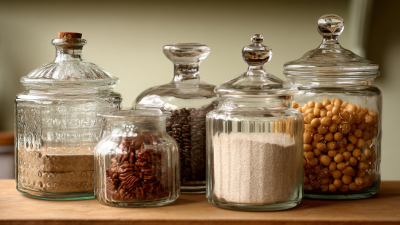
The preservation of honey is a topic of increasing importance, not only for maintaining its unique flavors and health benefits but also for ensuring its longevity. According to industry reports, the global honey market is projected to reach $12.2 billion by 2024, emphasizing the need for proper storage techniques to cater to this growing demand. One essential aspect that often gets overlooked is the role of Honey Jar Sealing Lids in prolonging the shelf life and quality of honey. Effective sealing mechanisms can significantly reduce the risk of moisture absorption and contamination, thus preserving honey's natural properties. This guide will delve into the intricacies of selecting the right honey jar sealing lids, offering practical tips and insights to help both producers and consumers safeguard their honey investments for years to come.

Preserving honey is essential not only for maintaining its rich flavor but also for ensuring its quality and longevity. Honey, with its natural antibacterial properties, has a remarkably long shelf life when stored under the right conditions. However, exposure to air and moisture can lead to fermentation or crystallization, compromising its integrity. Therefore, understanding how to effectively seal honey jars becomes crucial for any enthusiast or commercial producer.
The choice of sealing lids plays a significant role in the preservation process. High-quality, airtight lids prevent oxidation and moisture from entering the jar, which can transform liquid gold into a less desirable product. Additionally, proper sealing techniques, such as vacuum sealing or using specialized honey jar lids, can significantly extend the shelf life of honey. This careful attention to detail not only enhances the honey's flavor profile but also ensures that it remains a natural sweetener for years to come, allowing consumers to enjoy its benefits without worrying about spoilage.
This chart illustrates the effectiveness of various honey jar sealing methods on preserving the quality and longevity of honey. The data represents the average retention of honey properties over time for different sealing techniques.
When it comes to preserving honey, choosing the right sealing lid for your jar can make a significant difference in maintaining its quality and taste. The market offers various types of honey jar sealing lids, each with their own pros and cons. For instance, metal lids are durable and provide a tight seal, but they can corrode over time, potentially affecting the honey. On the other hand, plastic lids are lighter and less prone to rusting, yet they may not create as rigorous a seal as metal counterparts, allowing air to seep in and compromise the honey's freshness.
Glass lids with rubber gaskets are another popular choice, combining the benefits of a snug fit with the aesthetic appeal of glass. According to a report by the National Honey Board, proper sealing of honey jars can reduce moisture absorption and inhibit fermentation, which is crucial for maintaining honey's longevity. However, these lids tend to be more expensive and may require extra care during cleaning to prevent mold growth.
Tips: Always ensure that the sealing surface is clean and dry before closing the jar. This helps create a better seal and prolongs the honey's shelf life. Additionally, storing honey in a cool, dark place can significantly enhance its preservation, regardless of the lid type you choose.
| Lid Type | Material | Pros | Cons |
|---|---|---|---|
| Screw-on Lid | Metal or Plastic | Secure seal, reusable | Can rust (metal), may require extra effort to open |
| Flip-top Lid | Plastic | Easy access, child-friendly | Less airtight, may wear out |
| Vacuum Seal Lid | Plastic with rubber seal | Extends shelf life, airtight | Requires vacuum pump, can be expensive |
| Ceramic Lid | Ceramic | Aesthetic appeal, natural material | Fragile, not airtight |
| Bail & Gasket Lid | Glass & Rubber | Very airtight, good for long-term storage | Bulkier, can be heavy |
When it comes to honey preservation, achieving an airtight seal is crucial to maintain its quality and taste over time. Honey is not just a delightful addition to teas and desserts; it also boasts numerous health benefits, such as reducing the risk of fatty liver. To keep honey fresh for up to two years without refrigeration, proper sealing techniques are essential.
Using high-quality sealing lids is paramount. Opt for lids that provide a secure fit and can withstand fluctuations in temperature and humidity. A vacuum seal is often the best choice, as it eliminates air from the jar, preventing oxidation and preserving the honey's natural enzymes and nutrients. Always ensure that the rim of the jar is clean before sealing to avoid contamination, which can lead to spoilage. By following these best practices, you can enjoy the sweet benefits of honey while ensuring it remains in top condition for an extended period.

When it comes to honey preservation, understanding the impact of temperature and humidity is critical. Honey's natural properties allow it to last indefinitely; however, improper storage can lead to quality degradation. Ideal storage conditions involve maintaining a cool, consistent temperature, typically between 50°F and 70°F (10°C to 21°C), along with low humidity levels to prevent moisture absorption, which can lead to fermentation.

Recent studies have highlighted how thermally treated honey, specifically, exhibits improved moisture stability and acidity, making it more resilient during storage. Similar to optimal apple preservation techniques, where fruits must be kept in a cool environment to maintain freshness, honey requires careful considerations for temperature and humidity. Beekeepers emphasize sealing honey jars tightly and storing them away from light to maintain flavor and prevent crystallization—crucial steps for ensuring that the honey remains high-quality for an extended period.
When it comes to honey storage, understanding the industry standards is crucial for maximizing shelf life and maintaining quality. According to a report by the National Honey Board, honey can last indefinitely if stored correctly, with an ideal moisture content of less than 18%. This low moisture level significantly minimizes the risk of fermentation and spoilage. The materials and design of honey jar sealing lids play a pivotal role in achieving this optimal environment, ensuring that moisture and air are kept at bay.
Furthermore, the U.S. Department of Agriculture (USDA) emphasizes the importance of airtight seals for honey jars. A proper seal not only prevents contamination but also protects the product from external factors such as temperature fluctuations and light exposure. Specific standards suggest using food-grade plastic or glass with silicone or rubber gaskets to create airtight seals. These measures can dramatically extend the shelf life of honey, sometimes up to two years or more when stored in a cool, dark place. By adhering to these guidelines, beekeepers and honey enthusiasts alike can ensure their honey retains its delicious flavor and beneficial properties for as long as possible.






